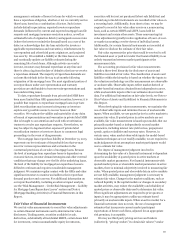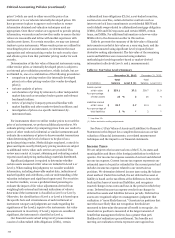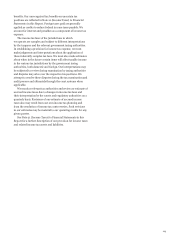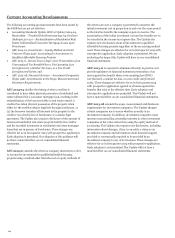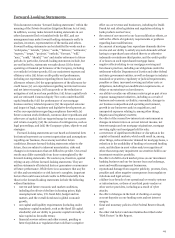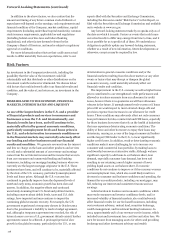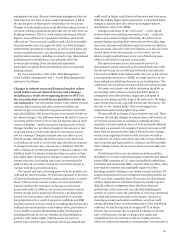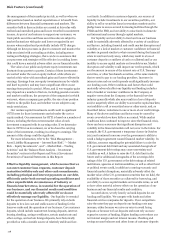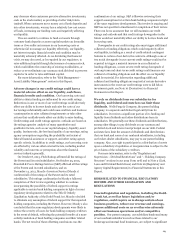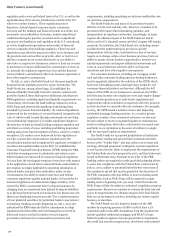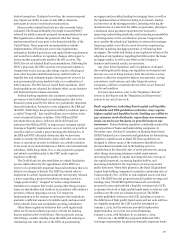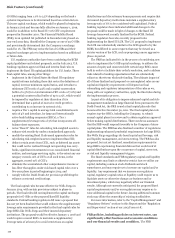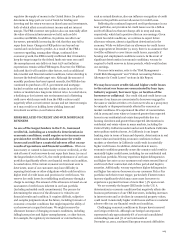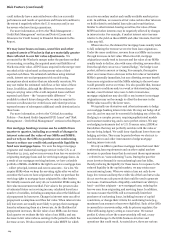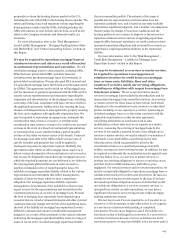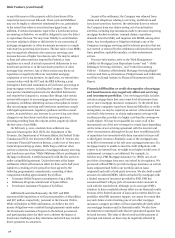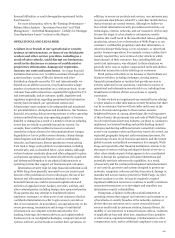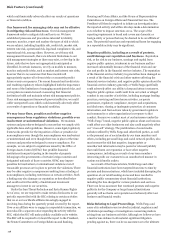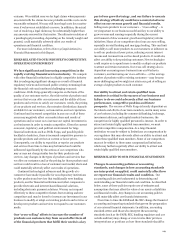Wells Fargo 2013 Annual Report Download - page 123
Download and view the complete annual report
Please find page 123 of the 2013 Wells Fargo annual report below. You can navigate through the pages in the report by either clicking on the pages listed below, or by using the keyword search tool below to find specific information within the annual report.limited exemptions. If adopted as written, the current proposal
may impact our ability to issue certain ABS or otherwise
participate in various securitization transactions.
Money market mutual fund reform is also currently being
evaluated. The Financial Stability Oversight Council (FSOC)
released for public comment proposed recommendations for new
SEC regulations to address the perceived risks that money
market mutual funds may pose to the financial stability of the
United States. These proposed recommendations include
implementation of floating net asset value requirements,
redemption holdback provisions, and capital buffer requirements
and would be in addition to regulatory changes with respect to
money market mutual funds made by the SEC in 2010. The
FSOC has not yet adopted final recommendations. Following the
FSOC’s proposals, the SEC issued its own proposed regulatory
changes that would, among other things, require a floating net
asset value for prime institutional money market funds, or
liquidity fees and redemption gates during periods of stress for
non-governmental money market funds, or a combination of
both measures. The SEC has not issued final regulations. Until
final regulations are adopted, the ultimate effect on our business
and financial results remains uncertain.
Federal banking regulators also continue to implement the
provisions of the Dodd-Frank Act addressing the risks to the
financial system posed by the failure of a systemically important
financial institution. Pursuant to rules adopted by the FRB and
the FDIC, Wells Fargo has prepared and filed a resolution plan, a
so called “living will,” that would facilitate our resolution in the
event of material distress or failure. If the FRB and FDIC
determine that our plan is deficient, the Dodd-Frank Act
authorizes the FRB and FDIC to impose more stringent capital,
leverage or liquidity requirements on us or restrict our growth or
activities until we submit a plan remedying the deficiencies. If
the FRB and FDIC ultimately determine that we have been
unable to remedy the deficiencies, they could order us to divest
assets or operations in order to facilitate our orderly resolution
in the event of our material distress or failure. Our national bank
subsidiary, Wells Fargo Bank, N.A., is also required to prepare
and submit a resolution plan to the FDIC under separate
regulatory authority.
The Dodd-Frank Act also establishes an orderly liquidation
process which allows for the appointment of the FDIC as a
receiver of a systemically important financial institution that is in
default or in danger of default. The FDIC has issued rules to
implement its orderly liquidation authority and recently released
a notice regarding a proposed resolution strategy, known as
“single point of entry,” designed to resolve a large financial
institution in a manner that would, among other things, impose
losses on shareholders and creditors in accordance with statutory
priorities, without imposing a cost on U.S. taxpayers.
Implementation of the strategy would require that institutions
maintain a sufficient amount of available equity and unsecured
debt to absorb losses and recapitalize operating subsidiaries.
Other future regulatory initiatives that could significantly
affect our business include proposals to reform the housing
finance market in the United States. These proposals, among
other things, consider winding down the GSEs and reducing or
eliminating over time the role of the GSEs in guaranteeing
mortgages and providing funding for mortgage loans, as well as
the implementation of reforms relating to borrowers, lenders,
and investors in the mortgage market, including reducing the
maximum size of a loan that the GSEs can guarantee, phasing in
a minimum down payment requirement for borrowers,
improving underwriting standards, and increasing accountability
and transparency in the securitization process. Congress also
may consider the adoption of legislation to reform the mortgage
financing market in an effort to assist borrowers experiencing
difficulty in making mortgage payments or refinancing their
mortgages. The extent and timing of any regulatory reform or the
adoption of any legislation regarding the GSEs and/or the home
mortgage market, as well as any effect on the Company’s
business and financial results, are uncertain.
Any other future legislation and/or regulation, if adopted,
also could significantly change our regulatory environment and
increase our cost of doing business, limit the activities we may
pursue or affect the competitive balance among banks, savings
associations, credit unions, and other financial services
companies, and have a material adverse effect on our financial
results and condition.
For more information, refer to the “Regulatory Reform”
section in this Report and the “Regulation and Supervision”
section in our 2013 Form 10-K.
Bank regulations, including Basel capital and liquidity
standards and FRB guidelines and rules, may require
higher capital and liquidity levels, limiting our ability to
pay common stock dividends, repurchase our common
stock, invest in our business or provide loans to our
customers. Federal banking regulators continually monitor the
capital position of banks and bank holding companies. In
December 2010, the Basel Committee on Banking Supervision
(BCBS) finalized a set of international guidelines for determining
regulatory capital known as Basel III. These guidelines are
designed to address many of the weaknesses identified in the
previous Basel standards and in the banking sector as
contributing to the financial crisis of 2008 and 2009 by, among
other things, increasing minimum capital requirements,
increasing the quality of capital, increasing the risk coverage of
the capital framework, increasing liquidity buffers, and
increasing standards for the supervisory review process and
public disclosure. When fully phased in, the Basel III guidelines
require bank holding companies to maintain a minimum ratio of
Common Equity Tier 1 (CET1) to risk-weighted assets of at least
7.0%. The BCBS has also proposed certain liquidity coverage and
funding ratios. The BCBS liquidity framework was initially
proposed in 2010 and included a liquidity coverage ratio (LCR)
to measure the stock of high-quality liquid assets to total net cash
outflows over the next 30 calendar day period. The BCBS
recently published revisions to the LCR, including revisions to
the definitions of high quality liquid assets and net cash outflows.
As originally proposed, the LCR would be introduced on
January 1, 2015, but the revisions provided for phased-in
implementation over a four year period beginning
January 1, 2015, with full phase-in on January 1, 2019.
In June 2011, the BCBS also proposed additional CET1
surcharge requirements for global systemically important banks
121


